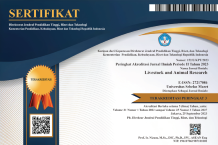The prevalence of Strongylida/strongyles in small ruminants in Manatuto Municipality in central region of Timor-Leste
Abstract
Objective: This research aimed to identify the prevalence of Strongyles in small ruminants (sheep and goats) in the central region of Timor-Leste.
Methods: There were two methods used in this research, i.e. multistage sampling to determine research sites and purposive sampling to collect samples. The total samples collected were 192. From the 192 samples collected, 96 samples were from goats and another 96 samples from sheep. The sample size was determined based on 50% design prevalence and 95% confidence level and absolute precision of 10%. Samples examined were fresh fecal samples from sheep and goats. The samples were tested using a native smear to identify the presence of worms’ eggs in the feces. The 95% confidence interval of the prevalence was calculated using the exact binomial method.
Results: Based on laboratory examination, it was found that the prevalence of Strongylida/strongyles in sheep was 21.88% (14.1-31.5%) and in goats was 20.83% (13.2-30.3%). Based on sex, the highest prevalence of Strongylida/strongyles of sheep was found in ram 25% (13.6-39.6%) compared to 18.75% (8.9-32.6%) in the ewe. In goats, however, the prevalence of Strongylida/strongyles was 25% (13.6-39.6%) in doe and 16.67% (7.5-30.2%) in bucks. Based on age, the highest prevalence in sheep was found in the age group of 9-12 months old 31.25% (16.1-50.0%), whereas in goats, the highest prevalence was found in the age group of 0-4 months old 28.13% (13.7-46.7%).
Conclusions: Based on this research, it was identified that the prevalence of Strongylida/strongyles in small ruminants (sheep and goats) in the central region of Timor-Leste was 21.35% (15.8-27.8%).
Keywords
Full Text:
PDFReferences
- Direçcão Geral de Estatística. 2015. [Internet]. Censo população e habitaҫão; c2015. [cited 2021 Dec 22]. Available from: https://www.statistics.gov.tl/category/publications/census-publications/2015- census-publications/
- Direcção Geral de Pecuária e Veterinária. 2015. Censo população animal. Ministério da Agricultura e Pescas. Dili.
- Simões, J., J. A. A. A. Cannas, J. A. Delgadillo, D. Lacasta, K. Voigt, and P. Chemineau. 2021. Review: Managing sheep and goats for sustainable high yield production. Anim. Int. J. Anim. Biosciences. 1-12. Doi: 10.1016/j.animal.202 1.100293
- Roeber, F., A. R. Jex, and R. B. Gasser. 2013. Next-generation molecular-diagnostic tools for gastrointestinal nematodes of livestock, with an emphasis on small ruminants: a turning point?. Adv. in Parasitol. 83: 267-333. Doi: 10.1016/B97 8-0-12-407705-8.00004-5
- Bowman, D. D. 2020. Georgis’ parasitology for veterinarians. 11th ed. Elsevier Health Sciences. New York. p. 307.
- Hodda, M. 2022. Phylum nematoda:a classification, catalogue and indeks of valid genera, with a census of valid species. Zootaxa. 5144:001-289. Doi: 10.11646/zoota xa.5144.1.1
- Sewalem, M., H. Kiros, G. Bassazin, M. Temsegen, S. Tarekegn, and B. Dar. 2017. Prevalence of haemonchus contortus of sheep slaughtered at Bahir Dar Municipal Abattoir, Bahir City, Ethiopia. Glob. Vet. 18: 269-276. Doi: 10.5829/idosi.gv.2017.269. 276
- Taylor, M. A., R. L. Coop, and R. L. Wall. 2016. Veterinary parasitology. 4th ed. Chichester west sussex wiley blackwel.
- Kumar, N., T. K. S. Rao, A. Varghese, and V. S. Rathor. 2013. Internal parasite management in grazing livestock. J. Parasit. Dis. 7:151-157. Doi: 10.1007/s12639-012-0215-z
- Tibebu, A., Y. Tamiru, and D. Abdeta. 2018. Prevalance of major gastrointestinal nematode and degree of parasite infestation in sheep of Bako agricultural research Center community based breeding program project small holder farms at Horro District. J. Dairy and Vet. Sci. 8:555740. Doi: 10.19080/JDVS.2018.08. 555740
- Roeber, F., A. R. Jex, and R. B. Gasser. 2013. Advances in the diagnosis of key gastrointestinal nemaotode infections of livestock, with an emphasis on small ruminants. Biotechonology Adv. 31:1135-1152. Doi: 10.1016/j.biotechadv.2013.01.008
- Thrustfield, M. and R. Christley (with). 2018. Veterinary Epidemiology. Wiley-Blackwell. Hoboken- New Jersey. p. 275.
- Stevenson, M. A. 2021. Sample size estimation in veterinary epidemiologic research. Frontiers in Vet. Sci. 7:539573. Doi: org/10.3389/fvets.2020.539573
- Thrusfield, M., R. Chirstley, H. Brown, P. J. Diggle, N. French, K. Howe, L. Kelly, A. O’Connor, J. Sargeant, and H. Wood. 2018. Vet. Epidemiology. 4rd ed. Willey-Blackwell. Doi: 10.1002/9781118280249
- Rahmann, G. and H. Seip. 2007. Alternative management strategies to prevent and control endo-parasite diseases in sheep and goat farming systems-a review of the recent scientific knowledge. J. Landbauforschung Völkenrode. 2:75-88.
- Guerrant, R. L., D. H. Walker, and P. F. Weller. 2011. Tropical Infectious diseases: principles, pathogens and practice. 3rd ed. Saunders Elseviers. Netherland. p. 779.
- Arsenopoulos, K. V., G. C. Fthenakis, E. L. Katsarou, and E. Papadopoulos. 2021. Haemonchosis: A challenging parasitic infection of sheep and goats. J. Anim. 11:1-28. Doi: 10.3390/ani11020363
- León, J. C. P., N. U. Delgado, and A. A. Florez. 2019. Prevalence of gastrointestinal parasites in cattle and sheep in three municipalities in the Colombian Northeastern Mountain. Vet. World. 12: 48-54. Doi: 10.14202/vetworld.2019.48-54
- Dorny, P., C. Symoens, A. Jalila J. Vercruysse, and R. Sani. 1995. Strongyle infections in sheep and goats under the traditional husbandry system in peninsular Malaysia. Vet. Parasitol. 56:1-3.
- McMilini, K. W., E. C. Webb, E. F. Donkin, and F. Pinkerton. 2012. Goat meat production and quality. CAB International. London
- Ayaz, M. M., M. M. Nazir, N. Samad, M. Zubair, M. Hanif, M. Aziz, A. S. Sheikh, A. Akbar, A. Waheed, A. Zaman, and N. Mahmood. 2018. Parasitism in goats: Husbandry management, range management, gut immunity, and therapeutics. In Kukovics, S., ed. Goat Science. IntechOpen. 298-308. Doi: 10.5772/ intechopen.74203
- Decandia, M., M. Yiakoulaki, G. Pinna, A. Cabidon, and G. Mole. 2008. Foraging behaviour and intake of goats browsing on mediteranian shrublands. In A. Pulina, editor, Dairy goats feeding and nutrition. Bologna, Italy. p. 163.
- Dias-Silva, T. P. and A. L. Abdalla. 2021. Sheep and goat feeding behavior profile in grazing systems. Acta Scientiarum, Anim. Sci. 43:e51265. Doi: 10.4025/actascianimsci. v43i1.51265
- Zvinorova, P. I., T. E. Halimani, F. C. Muchadevi, O. Matika, V. Riggio and K. Dzama. 2016. Prevalence and risk factors of gastrointestinal parasitic infections in goats in low-input low output farming system in Zimbabwe. Small ruminant research. 143: 75-83. Doi: 10.1016/j.smallrumres.2016.09.0 05
- Lambertz, C., I. Poulopoulou, K. Wuthijaree, and M. Gauly. 2018. Endoparasitic infections and prevention measures in sheep and goats under mountain farming conditions in Northern Italy. Small Ruminology Res. 164:94-10. Doi: 10.1016/j.smallrumres.2018.05.007
- Qamar, M. F., A. Maqbool, M. S. Khan, N. Ahmad, and M. A. Muneer. 2009. Epidemiology of haemonchosis in sheep and goats under different managemental conditions. Vet. World. 2:413-417. Doi: 10. 1.1.302.3619
- Maqbool, I., Z. A. Wani, R. A. Shahardar, I. M. Allaie, and M. M. Shah. 2017. Integrated parasite management with special reference to gastro-intestinal nematodes. J. Parasit. Dis. 41:1-8. Doi: 10.1007/s12639-016-0765-6
Refbacks
- There are currently no refbacks.










